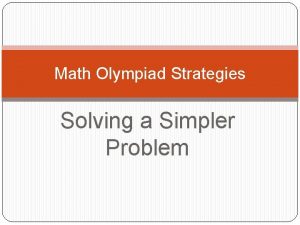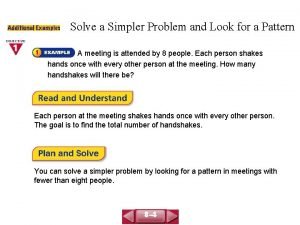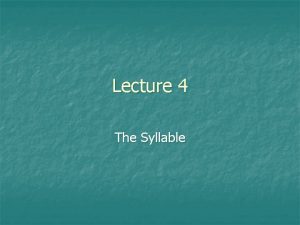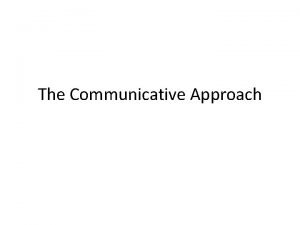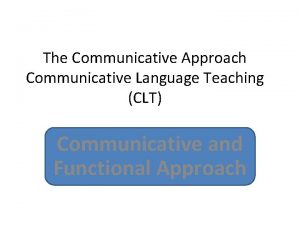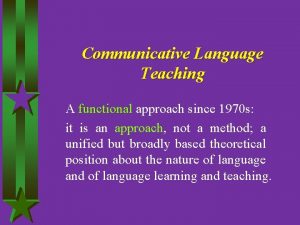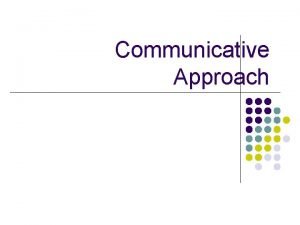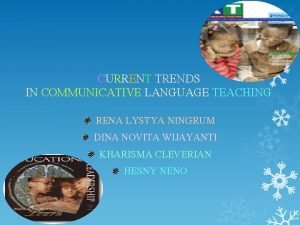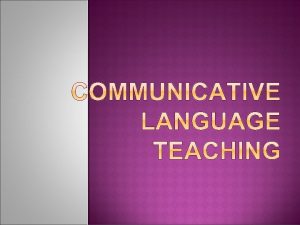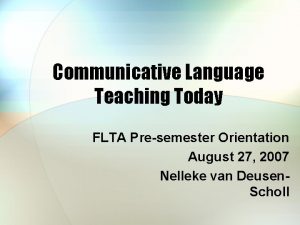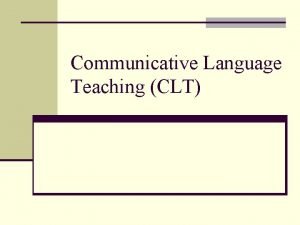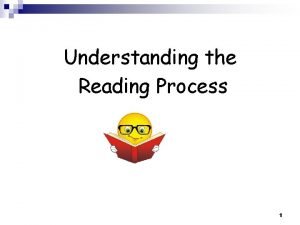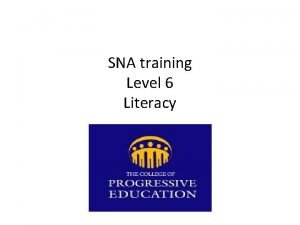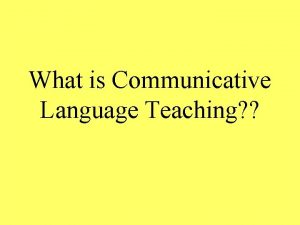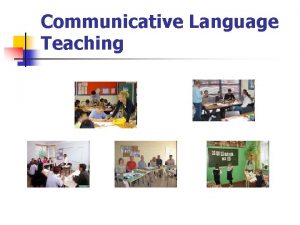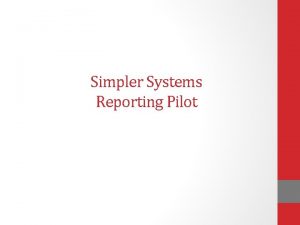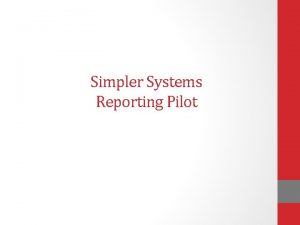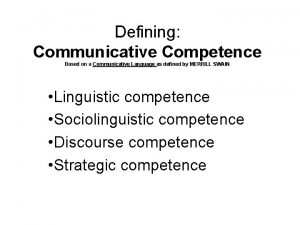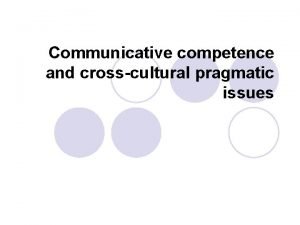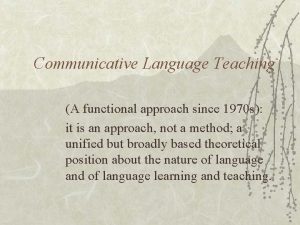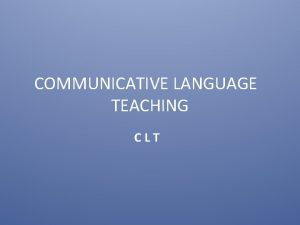Communicative Approach What is Communicative Language In simpler


























- Slides: 26

Communicative Approach

What is Communicative Language? � In simpler terms, it is the FUNCTIONAL/USABLE language. � Reading, writing, speaking and listening are all necessary parts of communicative competence. (e. g. reading a menu, ordering the food, or filling in an application form to work at the restaurant) � Language learning is also dependent upon the ability of people to interact purposefully with others in a variety of cultural and social contexts

WHERE DOES COMMUNICATIVE LANGUAGE TEACHING COME FROM?

BACKGROUND The communicative style of language teaching began in the 1970 s and developed in response to a growing dissatisfaction with prevailing methodologies, and in recognition of theoretical advances. It is not the direct result of any one way of looking at language and language learning, but is effectively the outcome of contributions given by the various different approaches.

BACKGROUND It started with Chomsky’s Cognitive Approach, paying particular attention to his distinction between performance and linguistic competence, and was developed by the socio-linguist, Hymes, and then subsequently by countless others.

BACKGROUND �Its origins are many, insofar as one teaching methodology tends to influence the next. The communicative approach could be said to be the product of educators and linguists who had grown dissatisfied with the audio-lingual and grammar-translation methods of foreign language instruction.

BACKGROUND �They felt that students were not learning enough realistic, whole language. They did not know how to communicate using appropriate social language, gestures, or expressions; in brief, they were at a loss to communicate in the culture of the language studied. Interest in and development of communicative-style teaching mushroomed in the 1970 s; authentic language use and classroom exchanges where students engaged in real communication with one another became quite popular.

BACKGROUND � In the 70 s, grammar was even completely abandoned by some who assumed students would naturally pick it up via communicative learning, but due to a sharp decline in learner accuracy and the realization that grammatical accuracy is a necessary part of linguistic competence and communication, the communicative teaching of grammar was integrated into the overall approach. Grammar was “necessary, but not sufficient” (Mc. Donough and Shaw 1993: 25) and the language learner has a whole bunch of other things to keep in mind too, such as: � 1. The social and cultural rules which apply to the context or situation. � 2. The relationship between the interactants. � 3. The purpose of the communication. � 4. The topic. � 5. How to use the channel of communication (spoken or written) for a specific purpose

Communicative Approach

Communicative Approach �Communicative language teaching makes use of real-life situations that necessitate communication. The teacher sets up a situation that students are likely to encounter in real life. �Communicative approach seeks to personalize and localize language and adapt it to interests of pupils. Meaningful language is always more easily retained by learners.

� Communicative approach is not just limited to oral skills. Reading and writing skills need to be developed to promote pupils' confidence in all four skill areas. By using elements encountered in variety of ways (reading/ summarizing/ translating/ discussion/ debates) - makes language more fluid and pupils' manipulation of language more fluent.

�Communicative approach seeks to use authentic resources. More interesting and motivating. . Authentic texts that can serve as partial substitute for community of native speaker: • Newspaper and magazine articles, • poems, • manuals, • recipes, • telephone directories, • videos, • news bulletins, • discussion programs

Communicative Method

Method 1. Focuses on language as a medium of communication. Recognizes that all communication has a social purpose - learner has something to say or find out. 2. Classroom activities maximize opportunities for learners to use target language in a communicative way for meaningful activities. Emphasis on meaning (messages they are creating or task they are completing) rather than form (correctness of language and language structure) - as in first language acquisition.

Method Use of target language as normal medium for classroom management and instruction. 4. More emphasis on active modes of learning, including pair work and group-work. 5. Primacy of oral work. Emphasis on oral and listening skills in the classroom. 6. Errors are a natural part of learning language. Learners trying their best to use the language creatively and spontaneously are bound to make errors. Constant correction is unnecessary and even counter-productive. Correction should be discreet / noted by teacher - let them talk and express themselves - form of language becomes secondary. 3.

Method 7. Use of idiomatic/ everyday language. This is kind of language used in communication between people - not a 'medium'/ grammatical/ examorientated/ formal language! 8. Activities are based on real-life communication because that is what we learn languages for, e. g. “This is my friend, Keiko. She’s from Japan”, raher than “This is a pen. That is a pencil”. 9. Activities are task-based in which language is used for a purpose, often based on an information gap and/or the sharing of information to achieve such a communicative purpose, e. g. selling fruit, making an appointment, a class survey or debating the pros and cons of school uniform. 10. Use of pair-work and group-work activities is common as well as individual and also teacher-led activities. Varied types of interaction are encouraged and nurtured. Learners hear more types of language from different sources, interact with more people, use language in context, hear it repeated, rephrased and clarified, ask and answer questions, build confidence and don’t have to speak in front of the entire class.

Method 11. Avoid age-old texts - materials must relate to pupils' own lives / must be fresh and real Changing texts and materials regularly keeps teacher on toes and pupils interested. 12. Use of visual stimuli - OHP/ flashcards, etc important to provoke practical communicative language. (3 stages presentation / assimilation/ reproducing language in creative and spontaneous way). 13. Visual resources can be exploited at whatever level one wishes - help to motivate and focus pupils' attention.

EXAMPLES OF COMMUNICATIVE EXERCISES

COMMUNICATIVE EXERCISES EAVESDROPPING � "Instructions to puts students" Listen to a conversation The exercise students in a real-world somewhere in asituation public place be prepared listening where and they must report to answer, in the target language, some Most general about what information overheard. likelyquestions they have an was said. opinion of the topic, and a class discussion could follow, in the target language, about their � 1. Who was talking? experiences and viewpoints. � 2. About how old were they? � 3. Where. Communicative were they when you such eavesdropped? exercises as this motivate students treating topics of their choice, at � 4. Whatthe were they by talking about? an appropriately challenging level. � 5. What did they say? � 6. Did they become aware that you were listening to them?

COMMUNICATIVE EXERCISES �"Objective. " Students listen to a passage to get general understanding of the topic or message. �"Directions. " Have students listen to the an announcement to decide what the speaker is promoting. (The announcement can be read by the teacher or played on tape. ) Then ask students to circle the letter of the most appropriate answer on their copy, which consists of the multiple-choice options.

HOW DO THE ROLES OF THE TEACHER AND STUDENT CHANGE IN COMMUNICATIVE APPROACH?

COMMUNICATIVE CLASSROOM � A classroom during a communicative activity is far from quiet � and frequently the scene of a classroom during a communicative exercise is active, with students leaving their seats to complete a task. � Classroom should provide opportunities for rehearsal of real-life situations and provide opportunity for real communication. Emphasis on creative role-plays/ simulations/ surveys/ projects/ playlets - all produce spontaneity and improvisation - not just repetition and drills.

ROLES OF TEACHERS IN CLT �Teachers in communicative classrooms will find themselves talking less and listening more— �becoming active facilitators of their students' learning (Larsen-Freeman, 1986). �The teacher sets up the exercise, but because the students' performance is the goal, the teacher must step back and observe, sometimes acting as referee or monitor.

ROLES OF STUDENTS IN CLL �Students are more responsible managers of their own learning. �The students do most of the speaking �practicing sounds themselves, permutating sentence patterns and getting chance to make mistakes and learn from doing so.

ADVANTAGES �The real-life simulations change from day to day. �Students' motivation to learn comes from their desire to communicate in meaningful topics. meaningful ways about �Because of the increased responsibility to participate, students may find they gain confidence in using the target language in general.

DISADVANTAGES �No environment of ESL �Difficulty in evaluating students’ performance �Ignore the training of reading and writing
 Solve a simpler problem strategy
Solve a simpler problem strategy Solve a similar but simpler problem example
Solve a similar but simpler problem example Lee alves
Lee alves Process of changing food into simpler substances
Process of changing food into simpler substances Lecture syllables
Lecture syllables What is the communicative
What is the communicative Clt activities examples
Clt activities examples Functional approach in language teaching
Functional approach in language teaching Communicative language teaching
Communicative language teaching Communicative language teaching
Communicative language teaching What is communicative achievement
What is communicative achievement Lystya
Lystya Language
Language Jack richards communicative language teaching today
Jack richards communicative language teaching today Communicative language teaching background
Communicative language teaching background Picture strip story in communicative language teaching
Picture strip story in communicative language teaching Communicative language teaching
Communicative language teaching A switch in a datagram network uses a
A switch in a datagram network uses a Cognitive approach vs behavioral approach
Cognitive approach vs behavioral approach Waterfall strategy marketing
Waterfall strategy marketing Multiple approach avoidance conflict
Multiple approach avoidance conflict Cognitive approach vs behavioral approach
Cognitive approach vs behavioral approach Research approach meaning
Research approach meaning Traditional approach to system development
Traditional approach to system development Deep learning approach and surface learning approach
Deep learning approach and surface learning approach Understanding the reading process
Understanding the reading process Language experience approach example
Language experience approach example
